In the past year, I have begun a series of projects to document the Punk and Hardcore scenes of Pittsburgh – my obsession since I was in High School.
It’s about the music.
But not just the music.
It’s about the people – day in and day out. The long-distance phone bills they ran up setting up shows. Scamming free copies on a university Xerox machine to make flyers.
It’s about record stores, too.
In record stores you found new sounds that you never knew existed. Found out about events. Met future band members.
Record stores were classrooms, confluence points for like-minded people.
Think about Jim Spitznagel who started Jim’s Records – the institution which gave way to Paul’s CDs and still survives as Sound Cat Records.
The nearly sacred Bloomfield space occupied by all three of these record stores is tucked back off the street in a former shoe store has transformed countless lives, my own among them.
Jim’s was a massive cultural force in the embryonic stage of Punk Rock in Pittsburgh and helped foster underground music through it’s terrible twos of Hardcore and into it’s Grunge adolescence.
I vividly remember the day – nine years old and in baggy skater shorts—that I first looked into the display case that held cassettes at Jim’s. I asked my Dad if he would buy me a copy of the Doors ‘LA Woman’ on cassette. He did.
The storefront at 4526 Liberty Ave resurfaced a few years later as Paul’s CDs — in 7th grade I tagged along while my sister and her friends picked up releases on Touch and Go, Sub Pop and SST. I would have gone there every day if I could have found a way.
I was 17 when I started working there — Randy Costanza was moving to New York and told me that Paul wanted to talk to me after school: “If you want to come down and hang out on Sunday, I’ll pay you, “ Paul said. That was the proclamation that altered the course of my life forever
I stayed at Paul’s until I was 25.
A few weeks ago, I caught up with Jim and talked with him about the early days of Pittsburgh Punk Rock and the legacy of his store.
Mind Cure: So you’re from Pittsburgh originally, growing up were you into records?
Jim: Oh yeah I was a record collector at a very young age. Early teens I was collecting records.
MC: Where would you go to get records growing up?
Jim: I can’t remember the name but there was a great store selling 45s almost exclusively. It was on Liberty Ave. downtown. I think the Subway station is there now. It was right at that Y intersection, there was a record shop but I can’t remember the name of it. I grew up in Westview, so for a kid who grew up in the North Hills, going into town was like a scary place. Everyone who hung out downtown were a couple years older and they all looked like really tough guys, like greasers <laughs>. But it was so cool because they had everything. And everyone was really knowledgeable. Everyone who hung out at the store was an avid collector, so it was a lot of fun to go there and just listen to them or ask them questions. That’s the number one place in my memory.
Pittsburgh has always been a great record town. There were a lot of great record shops all around. Even on McKnight Road there was a place called Tom’s, which was awesome – especially in the late 60’s/early 70’s. This guy named Tom, his last name might have been Majors I’m not sure. They had everything that was cool.
MC: Like underground stuff?
Jim: Nah it was all commercial stuff but it was stuff you couldn’t really find in the few National Record Mart stores that were around at the time. I mean you could definitely go and find Frank Zappa there, or Captain Beefheart.
MC: People also talk about there being a dividing point in Pittsburgh of pre-Jim’s and post-Jim’s. Pre-Jims Heads Together is most frequently mentioned as the go to place for more obscure stuff. Was that sort of the only game in town?
Jim: No, not really. I mean, Heads Together was absolutely great. You probably know John Artale, well he was the buyer there for a long time. And so you know he’s really hip so had great sense of what to stock. But at the same time that Heads Together was around there was another store that was a major influence on me opening Jim’s was this place called The Free People’s Store. It was in Oakland on Meyran Ave. It was on the second floor and that was THE underground store. They had all the underground stuff at the time. They had bootlegs before anybody even know what bootlegs were. They sold underground comics. So it was a meeting place too. It was a really cool place and their prices were great. Their prices were lower than everybody else. When you know, in the day when you could buy an album for $3.29 brand new.
But at that same time there was Free People’s Store, Heads Together, and Flo’s. Flo’s was more everything. They had anything you’d want and had tons of imports. It was like the place in town to go for import records.
Flo’s was the place you’d go if you were an avid record collector. Some of those early British magazines and American underground magazines like Bomp – they would write reviews of imports that you couldn’t find anywhere. Flo’s always had them. Like they had Prog stuff before anyone had ever heard of it. Even metal stuff like Scorpions, before anyone in the states ever heard of that stuff, Flo’s always had it.
That was such a great store.
MC: You started out selling records with Greg Eide in Etna, right?
Jim: Well he wanted to move from Etna to a bigger store on the North Side, on Federal Street. I think behind where the new baseball stadium is where we used to be. It was right over the 6th Street Bridge. I think the address was 11 Federal Street. He couldn’t afford the rent alone and he knew I had wanted to open up a shop myself. I had the records and he had the comics.
MC: What year was that?
Jim: Gosh, ’72? We split the rent there for about 9 months. And it was a really great spot for us but we both just grew until we outgrew each other. So after 9 months I moved up to Bloomfield. Not the current location but just down the street. It was just a really tiny storefront but it was more than what I needed at the time.
(click the images to see them full size)

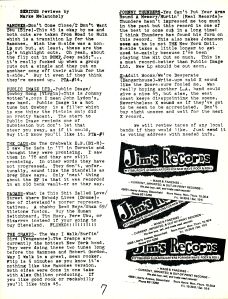

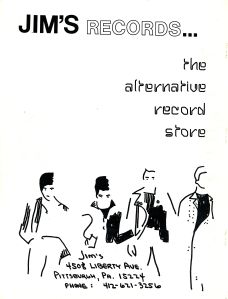
MC: Was Pittsburgh Guitars there when you moved to Bloomfield?
Jim: No he moved in after I got there.
MC: So what made you move to Bloomfield?
Jim: Well the neighborhood was safe. The neighborhood was kind of friendly, the young people were friendly. It was the kind of place where people peeked out their doors when you parked your car in front of their house. They wanted to know who you were. Polish Hill was the same way. The older generation was just like, “Who is this? Why are they parking in front of my house.” This was when people would put chairs in their parking space in the winter.

MC: Oh people still do that. They do it all year now.
Jim: (Laughs) Yeah, but there wasn’t much culturally there except for good bars and Donatelli’s, which was always a fantastic Italian deli. But the rent was really cheap. It was on a major road in town. Close to Shadyside. Close to Oakland. And I was really really lucky. There was no master plan, you know? I’m sure you understand. I was just following my passion. I just had to do this.
MC: Jim’s became known as the punk record store. Did you have a plan like that when you opened? Did you want it to be a certain type of store?
Jim: No but I wanted to attract collectors because that’s what I was. I just wanted to follow my passion. You know it’s what I loved. When I started on the North Side it was just used records. There was an importer at the time called Jem and they had this sales guy working there and we just clicked. You know he’d say “try stocking these 45s on Stiff Records.” It was like Elvis Costello and The Damned. Nobody really knew what that stuff was. Being a collector and reading Bomp magazine and the British papers I knew what it was. I knew I wanted it. So I started stocking the things I wanted.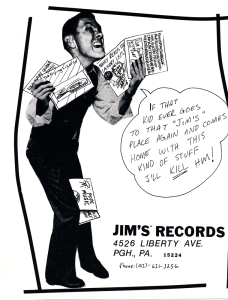
<laughs> Maybe you can understand that! So I figured if I wanted it I could probably find at least a few people who can’t find this stuff anywhere. So by the time I moved to Bloomfield it was getting more like 50/50 imports and used records.
The plan was to just be like a cool place where I would want to go. If someone else had that store I probably would have been a customer there and I probably would not have opened it myself. But I needed it. I needed that store to feed my own interests <laughs>.
MC: Since you brought imports up, when I was working at Paul’s people would come in looking for certain stuff and it might take you a week or two to get a copy of an import release for them. Jim’s being pre-internet and not a lot of awareness of what some of this stuff was, it couldn’t have been easy to find a lot of those records. You know Red Bob, right?
Jim: Oh yeah of course.
MC: Red Bob told me about how he remembers that from when he first read about the Stooges Funhouse that it took him over two years to actually find a copy of that record. Like you couldn’t just walk into a store and expect to find Funhouse, you really had to seek it out. But people talk about Jim’s like it was the place you could go and you would have those records.
Jim: At first it was a little bit of a trick to track more obscure stuff down, but after I built up some relationships with a couple of distributors in England, the imports were easy. As far as the US stuff it was also pretty easy. Does the distributor Galaxy still exist?
MC: Galaxy got bought by another distributor in Ohio I think. I actually never had a Galaxy account, everything I do at Mind Cure is all small label, independent stuff.
Jim: They were a good distributor and they were really friendly. Well, I always paid my bills so they were really friendly to me. But if someone came in looking for something like The Stooges, which I always stocked all their stuff, but if we didn’t have it stock, it would only take me a couple of days to get it. I would call Galaxy and it would be here in two days.
The thing is, I grew up in an entrepreneurial family so I’ve always known instinctively how to do business. I was always very friendly with my vendors and paid my bills on time, and in return they would bend over backwards to get me what I needed because they’re looking to make a sale just like you are.
Even when Galaxy had a smaller place on Forbes Ave. down by Duquesne, I would go in there and they would have a box of 45s, say Patti Smith 45s, and they would go “we ordered this because we figured you’d want it.
And they would even let me know when things were being cut out, I went in one time and they said “we know you’ve bought several copies of this album called Nuggets, well it’s just been deleted and we have two boxes. Do you want them? We’ll sell them to you really cheap.” And I go “OK!” <laughs>.
Fortunately I was friendly with all these guys and they all knew my interests. If anything came along that was weird in their eyes, they knew I would want it. So that really helped a lot.
MC: During the time you had the store there were a lot of the newer indie labels taking off…
Jim: Oh yeah and I loved that – you could deal directly with the label. And any time I could deal directly with a band or a label, that’s what I would do. Because then, you know, they’re getting the full price. I’m a big advocate of the label and the band getting everything they deserve. Because so many bands just, you know, starve. It’s hard.
And later when indie/grunge stuff became popular, I was trying to keep up with other things like imports, jazz, reggae, you know all different kind of stuff like that, I was fortunate enough to have (current Sound Cat records owner) Karl Hendricks and Dave Martin working for me. Do you know Dave?
MC: Oh yeah, I worked as one of Dave’s interns at Matador when I was living in New York.
Jim: Dave’s the greatest guy. I can’t say enough good things about him. He became the indie buyer for Jim’s. It was fantastic. I couldn’t have been happier. He was so into it. He knew the labels. He knew the owners! He knew the bands. The bands knew him. I feel he kind of carried on the tradition that I started.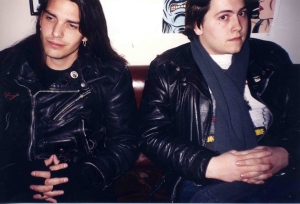
The first indie record that I ever bought, from the band, was “Little Johnny Jewel” by Television. I was in New York, probably at Bleecker Bob’s. They were playing the record and I go “what is this? I gotta have this.” And some guy turned to me and it was Richard Lloyd and he goes “oh, that’s my band. Our record just came out.” And I go, “I’ll take a box!” And he asked why and I told him I had a record shop in Pittsburgh.
That’s what really excited me. Doing that sort of thing.
MC: When did you start taking on employees? Did you have people working right off the bat?
Jim: Immediately.
MC: Did you intentionally hire people you knew from shopping at the store? Didn’t Eric, The Concrete Window, work for you?
Jim: Oh yeah Eric Tolchin, he worked for me for a long time. He was from Pittsburgh but he moved and was a cab driver in New York City. When he moved back to Pittsburgh he was driving past my store and saw a Ramones poster in the window and said “What the hell?” He couldn’t believe it. He stopped in and started working for me almost immediately. He was a lot of fun to work with.
MC: He certainly has not lost his sense of humor. I ran into him the other day. And Kris Kasperowski worked for you for a long time?
Jim: Yeah Kris worked for me for a long time. I have nothing but nice things to say about everyone who worked for me, except for one person and I don’t even remember her name. But Kris was great because she was so into it. At the same time Jill Snyder, I don’t know if you know her but her sister Erin might still be around town she played in a lot of bands.
MC: What about Karl, when did he start?
Jim: My memory of Karl…well there was a woman working for me named Alisa Dix and she was working for me, and Greg Pierce was working there at the same time. It was Alisa who said that I should give Karl a part time job. And at the time he was still living at home and his mom would give him a ride to work.
MC: <chuckles> That’s what my mom used to do when I was working at Paul’s.
Jim: Yeah he was only 18 and still in high school. He was writing music reviews for the school newspaper, one of the catholic schools, and they hated his reviews. They didn’t like the music he was writing about. And he was so great right from the get-go. I can’t tell you how happy I am that he owns that place now.
MC: I always pop in the store when I am in Bloomfield, when I went in and Paul told me he was thinking about selling the store I really encouraged Karl to do it. It just made so much sense that that’s exactly what he should do. And it seems like it’s going well for him too.
Jim: I can’t wait to stop in in a couple weeks.
MC: You’re going to see a lot of the same stuff. All the posters are still there. It’s a little different but it still looks a lot the same.
Jim: I saw a recent picture and I said “holy cow! I put those posters up there!”
MC: Oh yeah, people would come in and try to buy them, like the Devo poster or the Morrissey poster. People were always trying to buy them.
Jim: I had a Ramones life sized, cut out stand up from I think Rocket to Russia cover. Some girl came in, almost every day for two months, and would try to buy it. Finally she came in with a ton of money and I said “Fine! If you want it that bad.” But it was the only thing I ever sold. Fun stuff, I kept a lot of memorabilia from the store.
MC: So, Jim’s really evolved into a big meeting place for people involved with music in Pittsburgh. There’s a scene in (Stephanie Beroes Pittsburgh Punk film) Debt Begins at 20 filmed there, right?
Jim: Oh yeah, Bill Bored comes in and is trading in a used record and I just couldn’t stop laughing because Bill was just joking around the whole time. It was so funny.
(This scene can be viewed at the end of this segment of the film)
MC: I’ve been working on record reissues of Pittsburgh Punk records, I just finished Real Enemy…
Jim: Oh yeah I remember them. And that’s when Mike (LaVella) was just a kid. But he’s still like that today, just full of passion for the stuff he loved. I loved it when he came in. He was one of the greatest customers. He was so excited about things.
MC: Working on this project Mike talked a lot about the flyer window at the store and about how if you wanted to know what was going on in Pittsburgh you had to go check out the flyers at Jim’s.
Jim: And you know you talked about how it became kind of the punk store but I didn’t start off with that in mind. I loved all the music of that era and I still do. I still listen to it. From the Ramones, I guess the commercial end of things, to stuff from LA like the Weirdos. I just loved that stuff. So I stocked it and people started calling me the punk store. So all the punk kids would be there with all the hippies, the progressives, and the jazz people, and it all worked. A jazz guy would ask to put on some Ornette Coleman album and the next thing you know the punk kids are going, “what is this stuff?” They didn’t think that jazz could be weird. They knew jazz from what was on TV or what their parents listened to. Or I’d be playing a reggae record, something like that song “Pressure Drop” that The Clash covered. I’d put on the original version and kids would always be like, “hey, is this the song The Clash did?” At the time there were a lot of Jamaicans living in Pittsburgh. Jamaicans and West Africans. It’s one of the reasons why I carried a lot of that music. But there was a lot of crossover. But you know I’d play The Clash version and some guy from Jamaica was there who only knew the Toots and the Maytals version and everyone would just start talking. It was just such a mix. I loved it. It was so much fun to see that happen.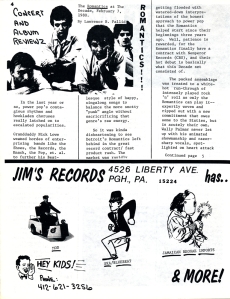
 MC: You were also involved in setting up shows and bringing bands?
MC: You were also involved in setting up shows and bringing bands?
Jim: Early on the clubs were Phase 3…everyone played Phase 3, every Pittsburgh band played at Phase 3 in Swissvale. And then what could be considered the bigger club, where’d you consider you’d made it, was The Decade. I mean that’s what people considered making it at the time. So different people were booking at Phase 3. Norman Nardini was booking at Phase 3 but he didn’t know any of the punk bands. So he would call me and ask me “uh, you think I should get The Weirdos? Who should open for them?” And the same thing would happen with The Decade. I became friends with Dom because he would come into the store once a week with a list of bands that he was offered and I would just go down the list, “nope, nope, nope.” And there were some groundbreaking concerts at The Decade, or even at Phase 3. The Police played at Phase 3. I would have rather seen Pere Ubu, but when you think of it, “Wow, The Police played Phase 3.” Or how U2 played The Decade. These were all bands that Dom had no idea who they were and I would just go “oh yeah, absolutely.” And so since I was helping him make money, we would share the billing. Like, “Presented by Jim’s Records” that sort of thing.
MC: You also did a Pittsburgh music fanzine?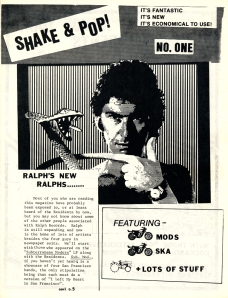

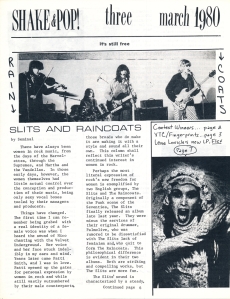
Jim: I actually did two. The one was called Shake and Pop, named after a Nick Lowe song. It was more “fan” based. The other one wasn’t really a “Pittsburgh” fanzine but more of the sort of thing all customers of mine would write reviews of live shows and records. It was definitely more in the vein of something like Trouser Press or Bomp magazine. I did have the Pittsburgh one but I can’t remember the name of it (Editors note: the magazine in question was called FRICTION).


MC: There were the record labels too, right? 2 of them, Public Records and Jim’s records. What made you decide to start putting out records? Were the Public Records releases all singles or were there some LPs too?
Jim: No they were all singles.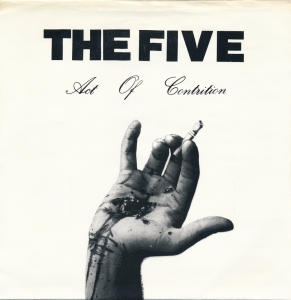



MC: There were some pretty amazing records on Public, like a Who’s Who of Pittsburgh bands at the time were on the label. Between 24 Minutes, The Five, and Dress Up As Natives.
Jim: To this day I love those records. I think they’re all great and under-appreciated.


MC: So what made you decide to start putting that stuff out.
Jim: Originally Carl Grefenstette from Pittsburgh Guitars wanted to know if I would partner with him on his label that released the Made in Pittsburgh albums. We did three records and I think he did a couple singles on his own of his band The Flash Cats. I liked that stuff – it was good bar music – but it wasn’t really what I was into at the time. I played in a bar band, but that was for money. We would get paid a lot of money to do that.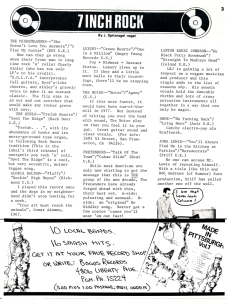
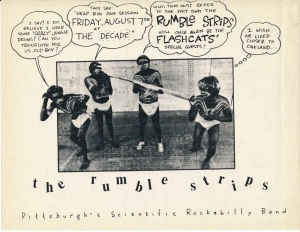
I just loved the music but I didn’t want to do it with him anymore, so I let him buy me out. Then I started Public Records with Wayne Honath – Wayno – you know him right?
MC: Oh yeah he did the logo for Mind Cure.
Jim: Oh yeah that’s right! – I can’t wait to see your counter – but yeah I did Public Records with Wayno and we didn’t have any goal in mind.
MC: Which one was number one?
Jim: I think it was a group called Ryjel The song was called “Dance or I’ll Kill You.”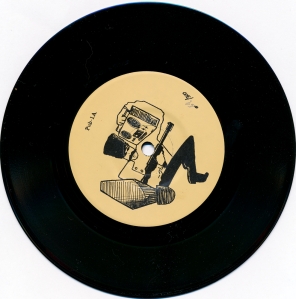
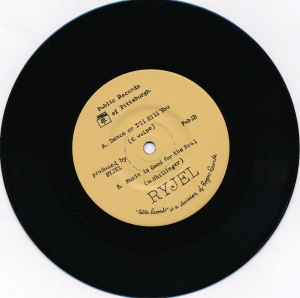
MC: (disappointingly) I actually don’t have that one.
Jim: Yeah it’s probably hard to get. There was no sleeve for that. I can’t remember what the B-Side was. It was a really cool song. It was kind of like, uh…it wasn’t punk, it wasn’t new wave…it was more like The Waitresses? That sort of thing. It was really funny of course. But I mean Disco was still a thing and Punk started to become a thing and then there was this in between sort of song called “Dance or I’ll Kill You.” I just liked that attitude, it was really funny.
MC: And then there was the 24 Minutes single, which I found in the basement at Paul’s when I worked there. I had no idea what it was, it didn’t have a sleeve. I love that record. Michael must have been really young. Was that the first thing he was ever on?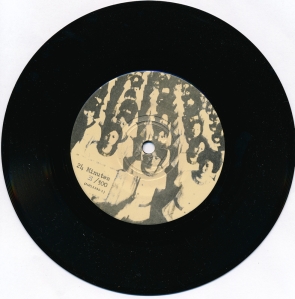
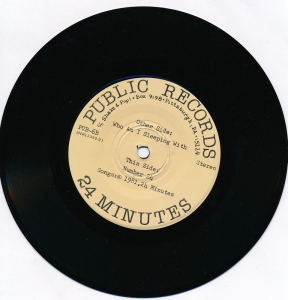
Jim: Oh yeah, he was a really young teenager.
MC: And then you did Jim’s Records. I’ve always wondered how you did the Pop Rivets Record.
Jim: I was in England a few times and I came back with a few Milkshakes singles. They hadn’t had an album though so I called up Billy Childish on the phone. I tracked down his phone number. So I call him and he goes, “where are you calling from?” and I told him Pittsburgh, PA, “I’d love to put out your singles on a full album. What kind of deal do you want?” And he goes, “Oh, well send me 25 albums.”
So he sent me the 45s I didn’t have and a whole ton of photos of the band. He wrote the liner notes. He couldn’t have been better to work with.
MC: Was that the first US Billy Childish record?
Jim: Yes I believe.
MC: So what made you decide to sell the store? To get out of the record business?
Jim: Well I had done it for almost 20 years. I was starting to get a little burned out. And the music for me that mattered in the early 90’s was the indie/grunge stuff, some of the more harder edge punk stuff that was almost like metal. And I really liked that stuff but I didn’t love it. It just wasn’t turning me on like the punk stuff did or the jazz, reggae, or even blues. So the passion was starting to go. Plus, I dunno how long you’ve had Mind Cure, but 20 years is a long time to run a place like that.
It wasn’t just the stuff I was stocking or wasn’t just the employees but I was working like 120 hours per week. I put everything into that. I was never home. And if I hadn’t worked my ass off like that, it would have never worked. But I was fortunate enough to have all employees who had a strong work ethic. That’s one of the great parts about Pittsburgh. It’s so blue collar. If you hire someone to do what they love, they’re gonna work their ass off.
MC: It carried all the way through my time at Paul’s as well. I’d work all the days everyone else wanted off. It really was sort of like a family where everyone is sort of covering for each other and we all wanted to make sure the store stayed there.
Jim: I tried to treat all my employees as good as I could. I mean once a month I’d take everyone out for Chinese food. It sounds kind of corny but we’d go and just have a ball. It was like a family.
In any case I just got too burned out. And it was taking too much out of me. It was a great life to have, but it was the only life I had. I wasn’t exploring who else I was and what else I was interested in. I just didn’t have time to do any of it.
MC: So then you went to the Andy Warhol museum?
Jim: Yeah I had met the director at the time, Mark Francis, we met for lunch one day. I told him that I had a ton of record covers that Andy Warhol designed and I asked him if he would want them for the museum, I told him I would just donate them. And every now and then when I go to the museum I’ll see a John Lennon cover that says “Donated by James….” I mean that’s all I really wanted <laughs>.
So we started talking. I was talking about getting out of the store and retiring. I always kind of knew what to do with money. I came from a family of entrepreneurs. My mother had seven brothers who owned businesses and they all retired early – they could because they made smart investments. So part of me, I was just a fanboy, just like you, just like everyone who goes into this, but I recognized that I had to put money away. I had to invest. What was I going to end up with? I didn’t want to be one of those crabby old record guys at the record shows talking to themselves. I didn’t want to become that caricature! Fortunately I sold the business and I retired. I didn’t have to do anything.
In any case I was talking to the guys at the Warhol and I thought that I could do something there. I always liked art. I always liked Andy Warhol. They wanted to have the museum shop be independent from the Carnegie. Because all the money from the Carnegie shops goes to one place. The Warhol figured that their shop would be a moneymaker, and they wanted to keep all the money. So they hired me to start the shop as an independent business inside The Warhol. That’s changed since I left.
I had to fight for that too but I loved it. I only worked there for like four years but I liked it a lot.
MC: And you’re still making music today?
Jim: Yeah I’m making improvised electronic music. I play in a duo called The Electric Golem. And we have this whole thing that we sell to colleges. We usually go by grant money. The other guy in the band is Trevor Pinch, he’s a professor at Cornell. He also wrote the book called “Analog Days” which is a history of the Moog synthesizer. I read the book and I read the back flap and I go, “he lives in Ithaca?” So I called him up and we’ve been friends ever since.
He’ll go give a lecture on how the Moog synthesizer works and how electronic music has changed our culture, then we do a concert and a workshop. He has vintage Moog gear so if anyone wants to come up and see how the vintage gear works they can do that. I use all digital gear. Kids will come up and have their iPods, we’ll talk and trade apps all the time. Which is really fun. It’s all improvisational and experimental so you know, there’s a small audience for it, but it’s a labor of love.
I also do visual art now, which is a bigger part of my life than music. I do shows around Ithaca here and once every few years I’ll do a show in New York City. I love both worlds. I love doing both things. I consider myself very lucky in life and Jim’s Records was a big part of it.
______________________________________________________________
Thanks to Wayno for use of his archives, Mike LaVella for photographs and make sure to seek out the full version of Debt Begins at 20 which has been playing on a loop in the contemporary galleries at the Carnegie Museum in Oakland.

Jim’s is where I got my new wave/punk/avant/dub education. It was the best aesthetic clubhouse a music freak could ever have. Thanks for everything, JS.
Jim was actually on the North Side in 1976. I know because I bought Bowie’s Low there at that
time. A few months later he was in Bloomfield at a really small place. I got The Pistols, 45’s, and
The Clash lps right on the cusp of 77/78. And when he moved up the street to the present
location (Paul’s & Sound Cat) I helped moved lps up the street via a dolly. I was 19 and weighed
110 lbs. That was a trip.
Great article! Jim’s was the place to go for punk and other obscurities, and Jim deserves tons of credit for helping foster the local scene through his knowledge, musical insights, and by being a downright nice and friendly guy.